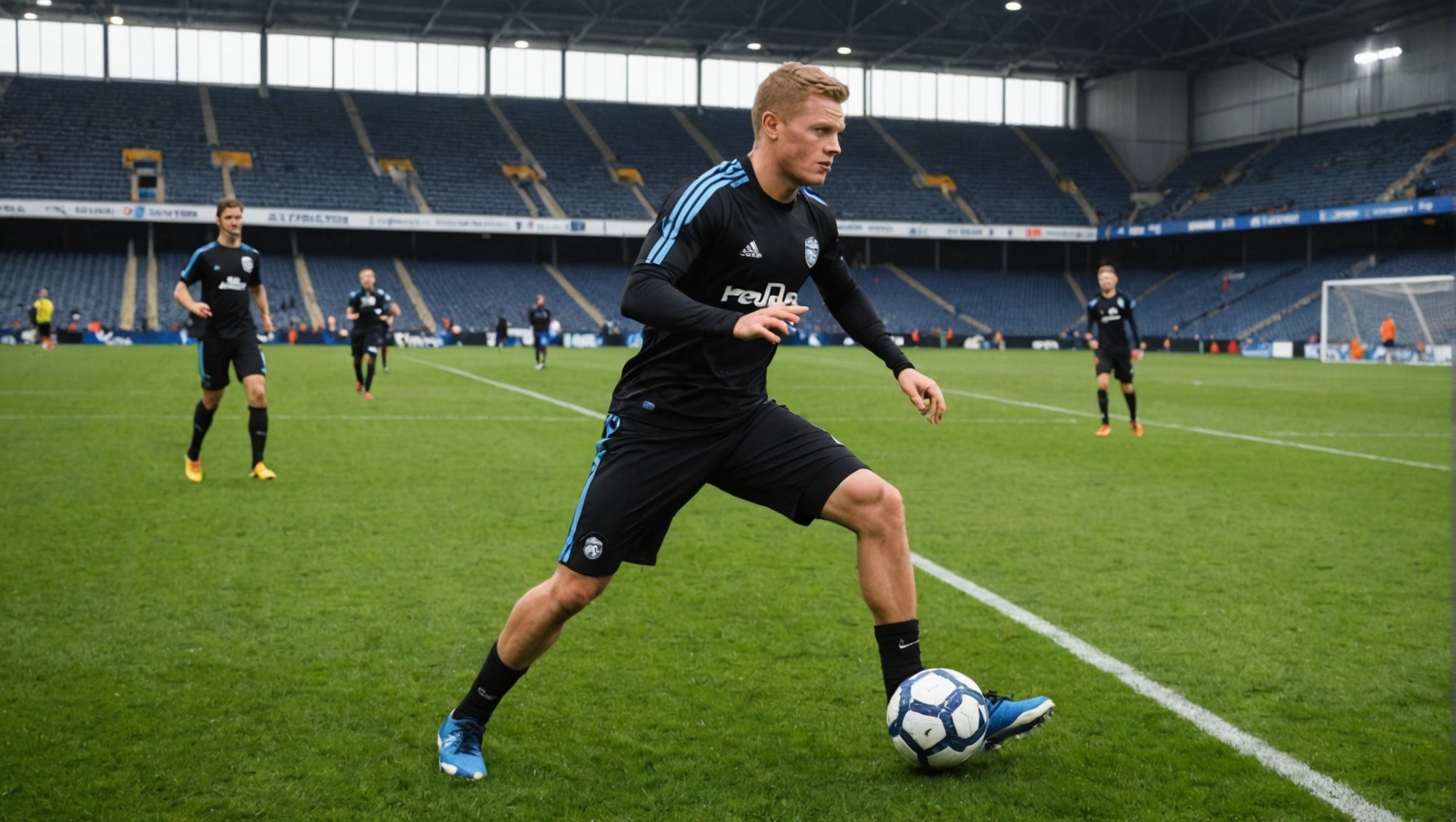Football players constantly seek ways to enhance their game skills. Biofeedback emerges as a powerful tool in this pursuit. By harnessing physiological data, athletes gain insights into their body’s responses under pressure. This not only helps in fine-tuning physical performance but also cultivates mental resilience. As players learn to regulate their heart rate, muscle tension, and stress levels, they unlock new levels of peak performance. Discover how biofeedback is reshaping training techniques and empowering players to elevate their game.
Overview of Biofeedback Technology
Biofeedback technology is a fascinating innovation that enhances performance by providing real-time feedback on physiological functions. This technology has become an integral part of sports science, helping athletes to optimize their training and performance. But what exactly is biofeedback?
Also to read : Top Strategies to Keep Football Players Motivated Amid Losing Streaks
Biofeedback involves using electronic monitoring devices to relay information about physiological activities, such as heart rate, muscle tension, and brainwaves. By making these internal processes visible, athletes can learn to control them, leading to improved performance.
Historically, biofeedback technology emerged in the late 1960s, initially used in clinical settings for stress reduction and pain management. Its application in sports science began to gain traction in the 1980s as researchers recognized its potential for performance enhancement. Today, biofeedback is a staple in the toolkit of many professional athletes and coaches.
Also read : Unlocking Individual Brilliance: The Role of Video Analysis in Elevating Football Players” Performance
There are several types of biofeedback used in athletic training:
- Electromyography (EMG) measures muscle activity, aiding in muscle relaxation and tension control.
- Heart Rate Variability (HRV) biofeedback helps athletes manage stress and improve recovery.
- Neurofeedback focuses on brainwave activity, enhancing focus and mental resilience.
By leveraging these technologies, athletes can fine-tune their physiological responses, pushing the boundaries of human performance.
Applications of Biofeedback in Football
In the realm of football, biofeedback technology is revolutionising athletic training by offering precise, real-time insights into player performance. This sports application allows coaches and players to enhance skills effectively. During practice sessions, biofeedback provides immediate data on physiological responses, enabling athletes to adjust their techniques and strategies on the spot. For instance, monitoring heart rate variability can help players manage stress levels, leading to better decision-making under pressure.
Biofeedback in football is not just about physical performance; it also plays a crucial role in mental conditioning. By focusing on brainwave activity, players can improve their mental focus and reduce anxiety, crucial for maintaining peak performance during high-stakes matches. Techniques such as neurofeedback help players enter a state of calm concentration, which is vital for executing complex plays with precision.
Moreover, biofeedback aids in skill improvement by targeting specific areas such as muscle tension and coordination. By receiving continuous feedback, players can refine their movements, enhancing their overall agility and efficiency on the field. This comprehensive approach to training ensures that athletes are not only physically prepared but also mentally resilient, pushing the boundaries of their capabilities in football.
Case Studies of Football Players Using Biofeedback
Exploring case studies of professional football players reveals the transformative impact of biofeedback technology. These real-world examples provide compelling evidence of how biofeedback can enhance performance and mental resilience.
One notable success story is that of a renowned midfielder who integrated biofeedback into his training regime. By focusing on heart rate variability and muscle tension, he reported significant improvements in his endurance and agility. His testimonial underscores the critical role of biofeedback in refining his techniques and boosting on-field performance.
Another player testimonial comes from a top-tier goalkeeper, who utilized neurofeedback to enhance his mental focus. He described how this technology helped reduce anxiety, allowing him to maintain composure during high-pressure matches. His experience highlights the importance of mental conditioning alongside physical training.
Biofeedback has also been instrumental in injury recovery. A well-known striker shared his journey of using electromyography to monitor muscle activity during rehabilitation. This approach facilitated a quicker return to peak performance, demonstrating biofeedback's versatility in sports science.
These biofeedback success stories illustrate not only the potential for improved athletic performance but also the personal growth and resilience players experience through this innovative technology.
Scientific Evidence Supporting Biofeedback Effectiveness
Scientific studies have extensively explored the effectiveness of biofeedback in enhancing sports performance, providing a solid foundation for its integration into athletic training. Biofeedback research has consistently demonstrated positive outcomes across various sports, including football.
Key studies have focused on quantifying performance metrics to evaluate the impact of biofeedback. For instance, research has measured improvements in heart rate variability, muscle tension, and brainwave activity, all critical indicators of athletic performance. These metrics offer a comprehensive view of how athletes can optimize both physical and mental capabilities through biofeedback.
One significant study highlighted the correlation between biofeedback and enhanced performance metrics in football players. Athletes who incorporated biofeedback into their training routines exhibited notable improvements in endurance, agility, and stress management. The findings suggest that biofeedback can be a transformative tool for football players, aiding in both skill development and mental resilience.
The implications of these findings are profound, as they provide empirical evidence supporting biofeedback's role in sports science. By leveraging the insights gained from biofeedback research, football players can refine their training strategies, leading to improved on-field performance and a competitive edge.
Integration of Biofeedback into Training Routines
Incorporating biofeedback tools into training routines offers athletes a structured approach to enhance performance. Players can start by identifying which physiological metrics are most relevant to their sport, such as heart rate variability or muscle tension. Using this data, athletes can tailor their practice routines to focus on specific areas of improvement.
Practical steps for integrating biofeedback into training include selecting the right devices. Recommended technologies, such as wearable sensors and EMG devices, provide precise real-time feedback, allowing players to monitor their progress continuously. These tools are instrumental in adjusting training intensity and techniques based on physiological responses.
Structuring training sessions around biofeedback involves setting clear objectives for each session. Athletes should aim to achieve specific physiological targets, such as optimal heart rate zones or muscle relaxation levels. By receiving immediate feedback, they can modify their practice strategies on the spot, ensuring that each session is both efficient and effective.
For optimal results, players should consistently incorporate biofeedback into their routines, gradually increasing their understanding and control over physiological processes. This integration not only improves physical performance but also enhances mental resilience, offering a comprehensive approach to athletic development.
Potential Challenges of Using Biofeedback
While biofeedback offers numerous benefits, athletes may encounter several challenges when integrating it into their training routines. Understanding these limitations is crucial for maximizing its effectiveness.
One common obstacle is the technical issues associated with biofeedback devices. Athletes may face difficulties with device calibration, data accuracy, or connectivity, which can hinder the reliability of feedback. Moreover, the complexity of some devices might require additional training, posing a barrier to seamless integration.
User adaptability is another concern. Athletes must learn to interpret data and adjust their training accordingly, which can be daunting for those unfamiliar with technology. The learning curve may deter some users from fully embracing biofeedback, limiting its potential benefits.
Psychological barriers also play a significant role in biofeedback's effectiveness. Some athletes may struggle with the pressure of constantly monitoring physiological metrics, leading to increased stress or anxiety. Additionally, over-reliance on biofeedback data might cause athletes to ignore their intuition or physical sensations, impacting performance.
Addressing these biofeedback drawbacks involves providing adequate support and education, ensuring athletes can confidently use the technology and overcome any challenges they may face.
The Role of Coaches in Implementing Biofeedback
Coaches play a pivotal role in integrating biofeedback into team training, employing effective coaching strategies to enhance player development. By facilitating biofeedback training, coaches can help players harness the technology's benefits, leading to improved performance and mental resilience.
A key aspect of successful implementation is creating a supportive environment for technology adoption. Coaches should encourage open communication, ensuring players feel comfortable discussing their experiences and challenges with biofeedback. This approach fosters a collaborative atmosphere, where athletes are more likely to embrace new methods and integrate them into their routines.
Monitoring progress is essential for adapting coaching strategies effectively. Coaches can track players' physiological data, such as heart rate variability and muscle tension, to assess improvements and identify areas needing further development. By analysing this data, coaches can tailor training programs to meet individual needs, optimizing performance outcomes.
Additionally, coaches should provide ongoing education and support, helping players understand and interpret biofeedback data. This empowers athletes to take ownership of their training, enhancing their ability to make informed decisions about their development. Through these efforts, coaches can significantly impact player growth, leveraging biofeedback to push the boundaries of athletic potential.
Future Trends in Biofeedback for Sports
The future trends in biofeedback technology promise to revolutionise sports training methodologies. Innovations in sports technology are set to enhance athletic performance further, offering more precise and personalised feedback.
Emerging technologies such as wearable sensors and AI-driven analytics are at the forefront of this revolution. These advancements enable real-time monitoring of a broader range of physiological metrics, providing athletes with comprehensive insights into their performance. As these tools become more sophisticated, they will offer increased accuracy and usability, allowing athletes to fine-tune their training with unprecedented precision.
In football, the evolution of biofeedback is likely to focus on integrating these technologies into everyday training routines. Predictions suggest that future systems will seamlessly blend physiological data with tactical analysis, offering a holistic view of player performance. This integration could lead to more tailored training programs, enhancing both physical and mental aspects of player development.
The potential impact on training methodologies is significant. As biofeedback becomes more ingrained in sports, coaches and athletes will increasingly rely on data-driven insights to guide their development strategies. This shift towards personalised training could redefine how athletes prepare, ultimately pushing the boundaries of human performance in sports.
Comparing Biofeedback with Other Performance Enhancement Techniques
In the realm of performance enhancement, athletes have a variety of training techniques at their disposal. While biofeedback is a cutting-edge tool, other methods such as visualization and neurofeedback also play crucial roles. Visualization involves mentally rehearsing skills to improve execution, enhancing focus and confidence. Neurofeedback, on the other hand, trains the brain to self-regulate, improving concentration and stress management.
When comparing these techniques, biofeedback's strength lies in its ability to provide real-time physiological data, enabling athletes to make immediate adjustments. Visualization, however, is less reliant on technology, making it accessible anywhere. Neurofeedback shares biofeedback's focus on mental conditioning but requires specialized equipment and expertise.
Despite its benefits, biofeedback may be limited by technical complexities and the need for device calibration. Visualization and neurofeedback, while effective, demand significant mental discipline and practice.
For optimal results, a holistic approach to performance enhancement is recommended. Combining biofeedback with other techniques can offer a comprehensive training regimen. By integrating real-time data with mental conditioning strategies, athletes can enhance both physical and mental aspects of their performance, achieving a balanced and effective training experience.
Conclusion and Key Takeaways
Biofeedback technology offers key insights into the physiological processes that drive athletic performance. For football players, integrating biofeedback into training routines can lead to significant performance improvement. By monitoring heart rate variability, muscle tension, and brainwave activity, athletes gain a deeper understanding of their physical and mental states. This awareness allows for tailored adjustments in training, leading to enhanced skills and resilience.
The summary of biofeedback's benefits highlights its role in both physical and mental conditioning. Athletes can achieve better stress management, improved focus, and refined techniques, pushing the boundaries of their capabilities on the field. Coaches play a crucial role in this integration, providing support and guidance to ensure effective use of the technology.
Football players are encouraged to explore biofeedback options as part of their training strategies. Embracing this innovative approach can offer a competitive edge, allowing athletes to optimize their performance and achieve their goals. By leveraging biofeedback, players can unlock new levels of potential, both individually and as a team, fostering a culture of continuous improvement and excellence in sports.













